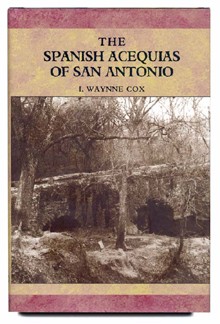Exploring SA's ancient waterways
| |
The acequias' history, engineering, and politics form the tributaries of Spanish Acequias of San Antonio by Waynne Cox, a well-regarded UTSA archeologist, who died in March 2004 shortly after completing his manuscript for the book.
Although ancient Roman engineers invented a version of an acequia system, the Moors further developed the technology, bringing it from the arid Middle East to Spain, where these waterways helped irrigate crops in the dry climate. When Spanish settlers arrived in San Antonio in the early 18th century, they used Indian slave labor to dig an elaborate acequia network, which grew as the city did - from San Pedro Springs in present-day San Pedro Park more than 10 miles south to Mission Espada.
Acequias direct water into a diversion dam, which funnels it into a mother ditch. Water is carried through the mother ditch to distribution canals whose sluice gates control the flow. Finally, water is funneled into discharge channels for crops, livestock, or people. Channels then return the remaining water to the original stream.
Acequia engineers built acqueducts, such as the one near Mission Espada, to carry water over obstacles, and studied the land's contours to guide the water's flow and direction. These details, Cox reports, apparently mystified their 19th-century counterparts, who in 1874, "discovered that water will not run uphill."
| The Spanish Acequias of San Antonio By I. Waynne Cox Maverick Publishing maverickpub.com $21.95, 93 pages ISBN: 189327134X |
To illustrate how little has changed in San Antonio since 1865, committees were appointed, plans were made, ordinances against dumping were passed, fines were levied - and few cleanup or repairs on the acequias were completed. The City, reported one local paper, was broke and couldn't pay for the upkeep.
After extensive debate - some thought acequias could supplement the modern sewer system, others believed they were too expensive to maintain - the City closed the network in 1912. Although in the '20s, Edward Arneson reinvigorated public attention to the acequias - an interest that continues today - they largely lie buried under asphalt, concrete, and buildings, except for notable examples at Mission San Jose and Mission Espada, and a rebuilt section behind the Hampton Inn downtown.
Today, 9,000 miles of water and sewer mains do the work of acequias, but Cox's book excels in giving readers a glimpse into the rise and fall of an engineering art form. In 1912, a city alderman waxed poetic about an acequia known as the Alamo Ditch: "I love to stop and gaze into its limpid depths. It reminds me of Venice."
Except for the couches. •
See related story "Life's a ditch" in this issue of the Current.
By Lisa Sorg

















